cruise control JAGUAR F TYPE 2015 1.G Quick Start Guide
[x] Cancel search | Manufacturer: JAGUAR, Model Year: 2015, Model line: F TYPE, Model: JAGUAR F TYPE 2015 1.GPages: 16, PDF Size: 1.16 MB
Page 3 of 16
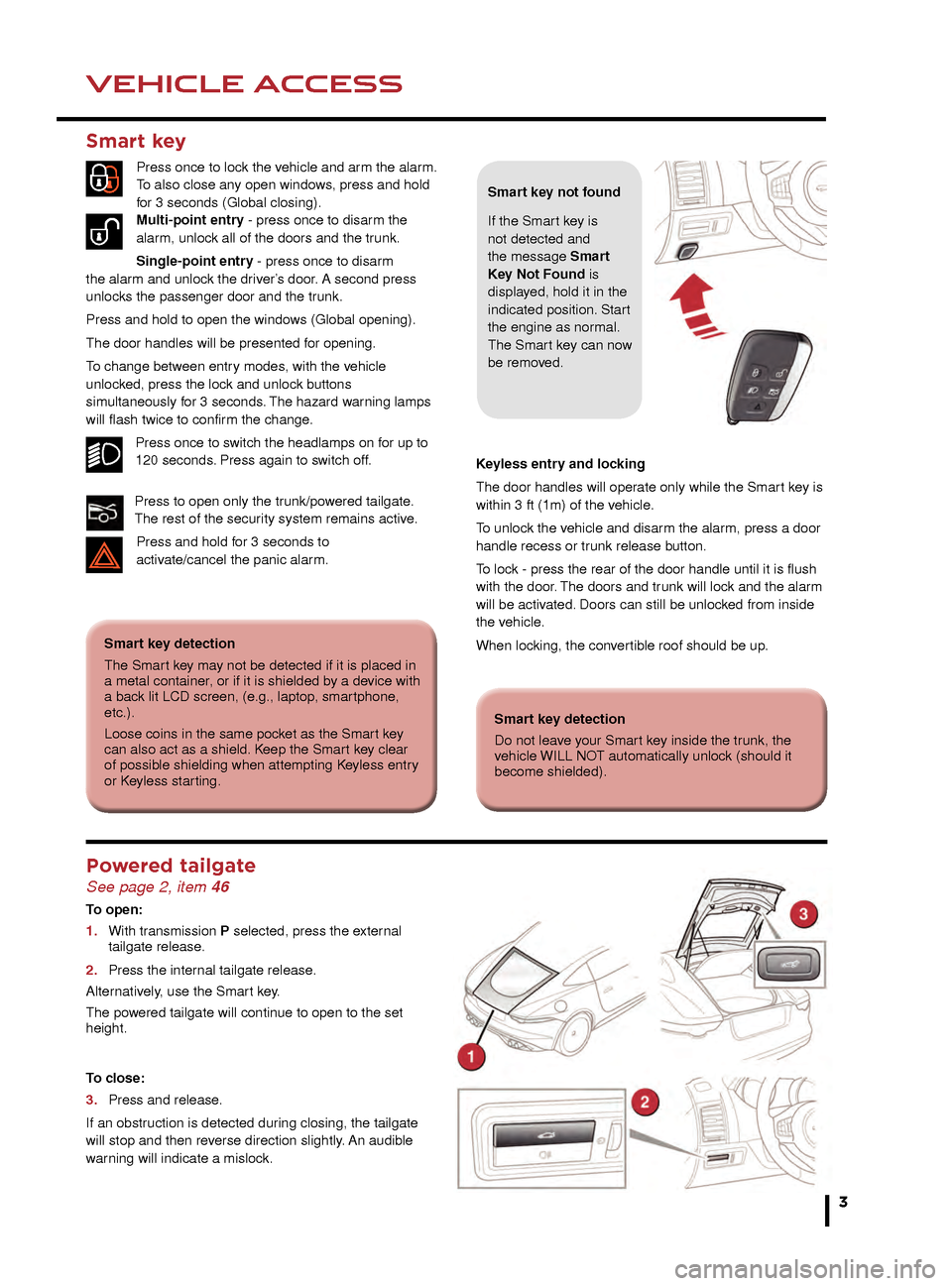
3
DRIVER CONTROLSVEHICLE ACCESS
26. Intelligent stop/start.
27. Deployable rear spoiler switch.
28. Electric parking brake.
29. Stability control.
30. Driving mode.
31. STOP/START.
32. Heated rear screen.
33. Heated windshield.
34. Windshield maximum defrost.
35. Hazard warning lamps on/off.
36. Climate control recirculation.
37. Air conditioning on/off.
38. Climate control AUTO mode.
39. Cruise control or Automatic speed limiter.
40. Horn.
41. Steering wheel adjuster.
42. Audio/video mode selection.
43. Audio/video and phone controls.
44. Instrument illumination.
45. Fog lamps on/off.
46. Trunk/tailgate release.
47. Exterior mirror controls.
48. Window controls.
Note: Steering wheel design may differ.
Smart key
Press once to lock the vehicle and arm the alarm.
To also close any open windows, press and hold
for 3 seconds (Global closing).
Multi-point entry - press once to disarm the
alarm, unlock all of the doors and the trunk.
Single-point entry - press once to disarm
the alarm and unlock the driver’s door. A second press
unlocks the passenger door and the trunk.
Press and hold to open the windows (Global opening).
The door handles will be presented for opening.
To change between entry modes, with the vehicle
unlocked, press the lock and unlock buttons
simultaneously for 3 seconds. The hazard warning lamps
will flash twice to confirm the change .
Press once to switch the headlamps on for up to
120 seconds. Press again to switch off.
Press to open only the trunk/powered tailgate.
The rest of the security system remains active. Press and hold for 3 seconds to
activ
ate/cancel the panic alarm. Keyless entry and locking
The door handles will operate only while the Smart key is
within 3 ft (1m) of the vehicle.
To unlock the vehicle and disarm the alarm, press a door
handle recess or trunk release button.
To lock - press the rear of the door handle until it is flush
with the door. The doors and trunk will lock and the alarm
will be activated. Doors can still be unlocked from inside
the vehicle.
When locking, the convertible roof should be up.
Smart key detection
The Smart key may not be detected if it is placed in
a metal container, or if it is shielded by a device with
a back lit LCD screen, (e.g., laptop, smartphone,
etc.).
Loose coins in the same pocket as the Smart key
can also act as a shield. Keep the Smart key clear
of possible shielding when attempting Keyless entry
or Keyless starting.
Smart key not found
If the Smart key is
not detected and
the message Smart
Key Not Found is
displayed, hold it in the
indicated position. Start
the engine as normal.
The Smart key can now
be removed.
Smart key detection
Do not leave your Smart key inside the trunk, the
vehicle WILL NOT automatically unlock (should it
become shielded).
Powered tailgate See page 2, item 46
To open:
1.
With tr
ansmission P selected, press the external
tailgate release
.
2.
Press the inter
nal tailgate release.
Alternatively, use the Smart key.
The powered tailgate will continue to open to the set
height.
To close:
3.
Press and release
.
If an obstruction is detected during closing, the tailgate
will stop and then reverse direction slightly. An audible
warning will indicate a mislock.
Page 6 of 16
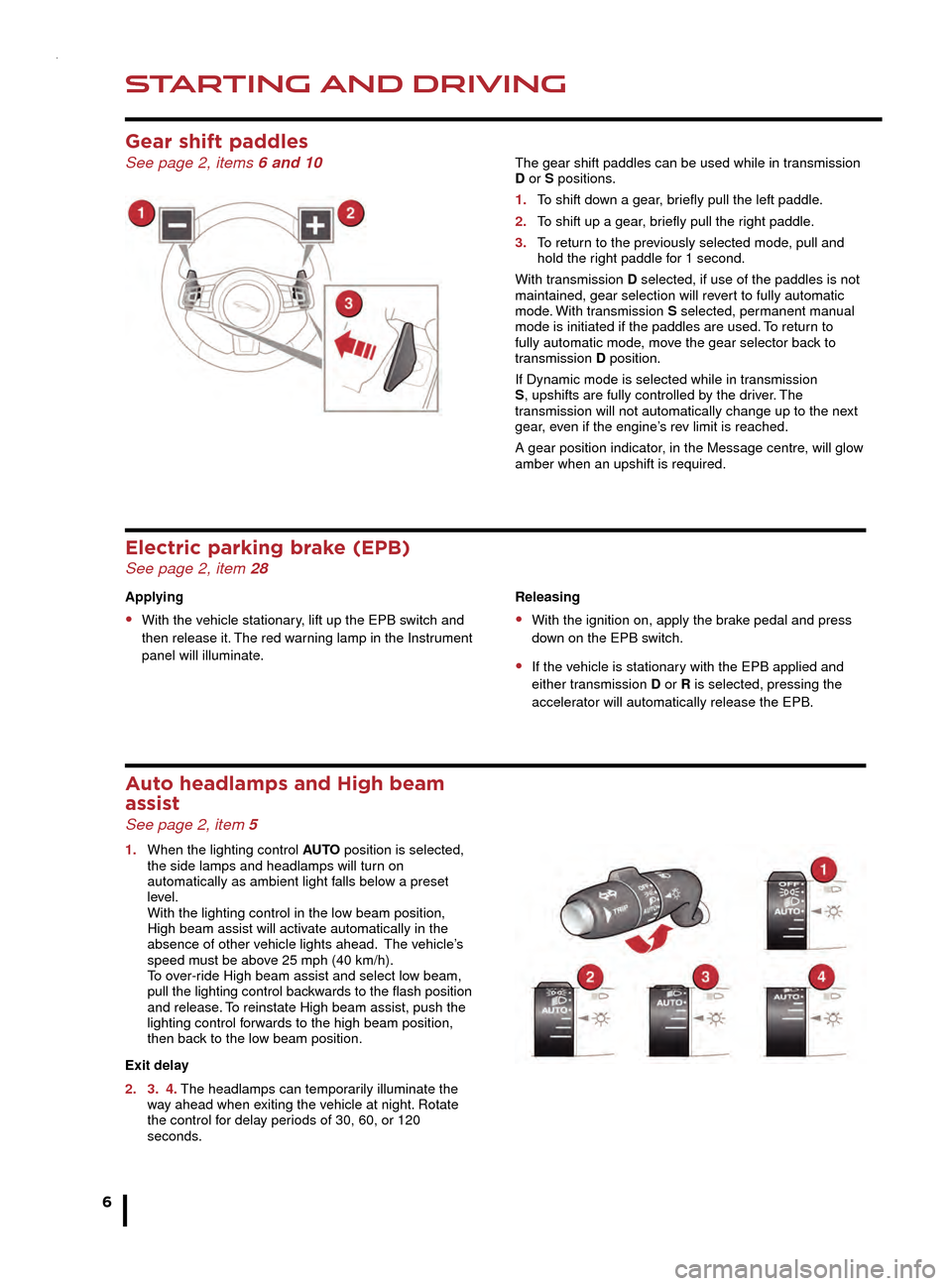
STARTING AND DRIVING
6
STARTING AND DRIVING
Releasing
• With the ignition on, apply the brake pedal and press
do wn on the EPB switch.
• If the vehicle is stationary with the EPB applied and
either tr ansmission D or R is selected, pressing the
acceler
ator will automatically release the EPB.
Electric parking brake (EPB) See page 2, item 28
Applying
• With the vehicle stationary, lift up the EPB switch and
then release it. The red warning lamp in the Instrument
panel will illuminate
.
Auto headlamps and High beam
assist
See page 2, item 5
1. When the lighting control AUTO position is selected,
the side lamps and headlamps will tur n on
automatically as ambient light f
alls below a preset
le
vel.
With the lighting control in the lo
w beam position,
High beam assist will activ
ate automatically in the
absence of other v
ehicle lights ahead. The vehicle’s
speed m
ust be above 25 mph (40 km/h).
T
o over-ride High beam assist and select low beam,
p
ull the lighting control backwards to the flash position
and release
. To reinstate High beam assist, push the
lighting control f
orwards to the high beam position,
then bac
k to the low beam position.
Exit delay
2.
3.
4. The headlamps can temporarily illuminate the
w
ay ahead when exiting the vehicle at night. Rotate
the control f
or delay periods of 30, 60, or 120
seconds.
Cruise control and Automatic
speed limiter (ASL)
See page 2, item 39
Setting the Cruise control speed
1. Accelerate to the desired speed, then press to set
and maintain the speed. Can also be used to
increase speed while Cruise control is operating.
2. Resumes the set speed after Cruise control has been
suspended.
3. Press to decrease the set speed.
4. Suspends Cruise control but retains the current set
speed in the memory.
5. Press to switch between Cruise control and ASL.
Intelligent stop/start See page 2, item 26
Intelligent stop/start is automatically activated when the
ignition is turned on. If the vehicle is stopped and the
brake pedal is applied, the engine will turn off (unless it
is required to support other vehicle systems). When the
brake pedal is released and a drive gear is selected, the
engine will restart.
A lamp in the Instrument panel will illuminate
while the engine is switched off by Intelligent
stop/start.
Gear shift paddles See page 2, items 6 and 10
Deployable rear spoiler (DRS) See page 2, item 27
The DRS will raise automatically when the vehicle’s
speed reaches 60 mph (96 km/h) and will retract when
the speed drops below 40 mph (64 km/h).
1. Press the switch to raise the DRS at vehicle speeds of
below 60 mph (96 km/h).
2. Press again to return to automatic mode.
Note: Coupe switch graphic is similar.
The gear shift paddles can be used while in transmission
D or S positions.
1.
T
o shift down a gear, briefly pull the left paddle.
2.
T
o shift up a gear, briefly pull the right paddle.
3.
T
o return to the previously selected mode, pull and
hold the r
ight paddle for 1 second.
With transmission D selected, if use of the paddles is not
maintained, gear selection will revert to fully automatic
mode. With transmission S selected, permanent manual
mode is initiated if the paddles are used. To return to
fully automatic mode, move the gear selector back to
transmission D position.
If Dynamic mode is selected while in transmission
S, upshifts are fully controlled by the driver. The
transmission will not automatically change up to the next
gear, even if the engine’s rev limit is reached.
A gear position indicator, in the Message centre, will glow
amber when an upshift is required.
Page 7 of 16
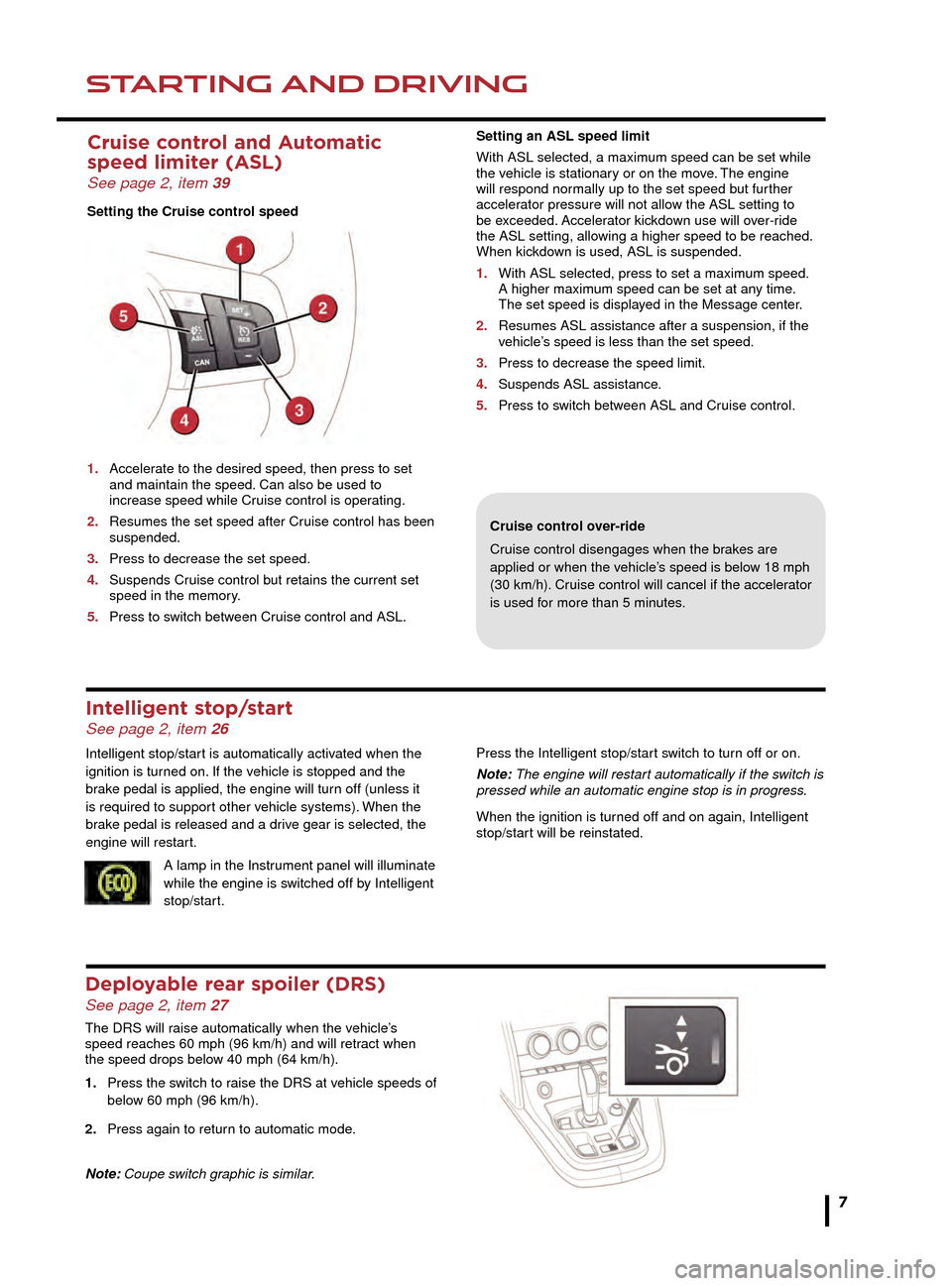
STARTING AND DRIVINGSTARTING AND DRIVING
7
Releasing
• With the ignition on, apply the brake pedal and press
down on the EPB switch.
• If the vehicle is stationary with the EPB applied and
either transmission D or R is selected, pressing the
accelerator will automatically release the EPB.
Cruise control over-ride
Cruise control disengages when the brakes are
applied or when the vehicle’s speed is below 18 mph
(30 km/h). Cruise control will cancel if the accelerator
is used for more than 5 minutes.
Cruise control and Automatic
speed limiter (ASL)
See page 2, item 39
Setting the Cruise control speed
1.
Acceler
ate to the desired speed, then press to set
and maintain the speed.
Can also be used to
increase speed while Cr
uise control is operating.
2.
Resumes the set speed after Cr
uise control has been
suspended.
3.
Press to decrease the set speed.
4
.
Suspends Cr
uise control but retains the current set
speed in the memor
y.
5
.
Press to s
witch between Cruise control and ASL.
Intelligent stop/start See page 2, item 26
Intelligent stop/start is automatically activated when the
ignition is turned on. If the vehicle is stopped and the
brake pedal is applied, the engine will turn off (unless it
is required to support other vehicle systems). When the
brake pedal is released and a drive gear is selected, the
engine will restart.A lamp in the Instrument panel will illuminate
while the engine is switched off by Intelligent
stop/start. Press the Intelligent stop/start switch to turn off or on.
Note: The engine will restart automatically if the switch is
pressed while an automatic engine stop is in progress.
When the ignition is turned off and on again, Intelligent
stop/start will be reinstated.
Setting an ASL speed limit
With ASL selected, a maximum speed can be set while
the vehicle is stationary or on the move. The engine
will respond normally up to the set speed but further
accelerator pressure will not allow the ASL setting to
be exceeded. Accelerator kickdown use will over-ride
the ASL setting, allowing a higher speed to be reached.
When kickdown is used, ASL is suspended.
1.
With ASL selected, press to set a maxim
um speed.
A higher maxim
um speed can be set at any time.
The set speed is displa
yed in the Message center.
2.
Resumes ASL assistance after a suspension, if the
v
ehicle’s speed is less than the set speed.
3.
Press to decrease the speed limit.
4
.
Suspends ASL assistance
.
5
.
Press to s
witch between ASL and Cruise control.
Deployable rear spoiler (DRS) See page 2, item 27
The DRS will raise automatically when the vehicle’s
speed reaches 60 mph (96 km/h) and will retract when
the speed drops below 40 mph (64 km/h).
1.
Press the s
witch to raise the DRS at vehicle speeds of
belo
w 60 mph (96 km/h).
2.
Press again to retur
n to automatic mode.
Note: Coupe switch graphic is similar.
The gear shift paddles can be used while in transmission
D or S positions.
1. To shift down a gear, briefly pull the left paddle.
2. To shift up a gear, briefly pull the right paddle.
3. To return to the previously selected mode, pull and
hold the right paddle for 1 second.
With transmission D selected, if use of the paddles is not
maintained, gear selection will revert to fully automatic
mode. With transmission S selected, permanent manual
mode is initiated if the paddles are used. To return to
fully automatic mode, move the gear selector back to
transmission D position.
If Dynamic mode is selected while in transmission
S, upshifts are fully controlled by the driver. The
transmission will not automatically change up to the next
gear, even if the engine’s rev limit is reached.
A gear position indicator, in the Message centre, will glow
amber when an upshift is required.
Page 8 of 16
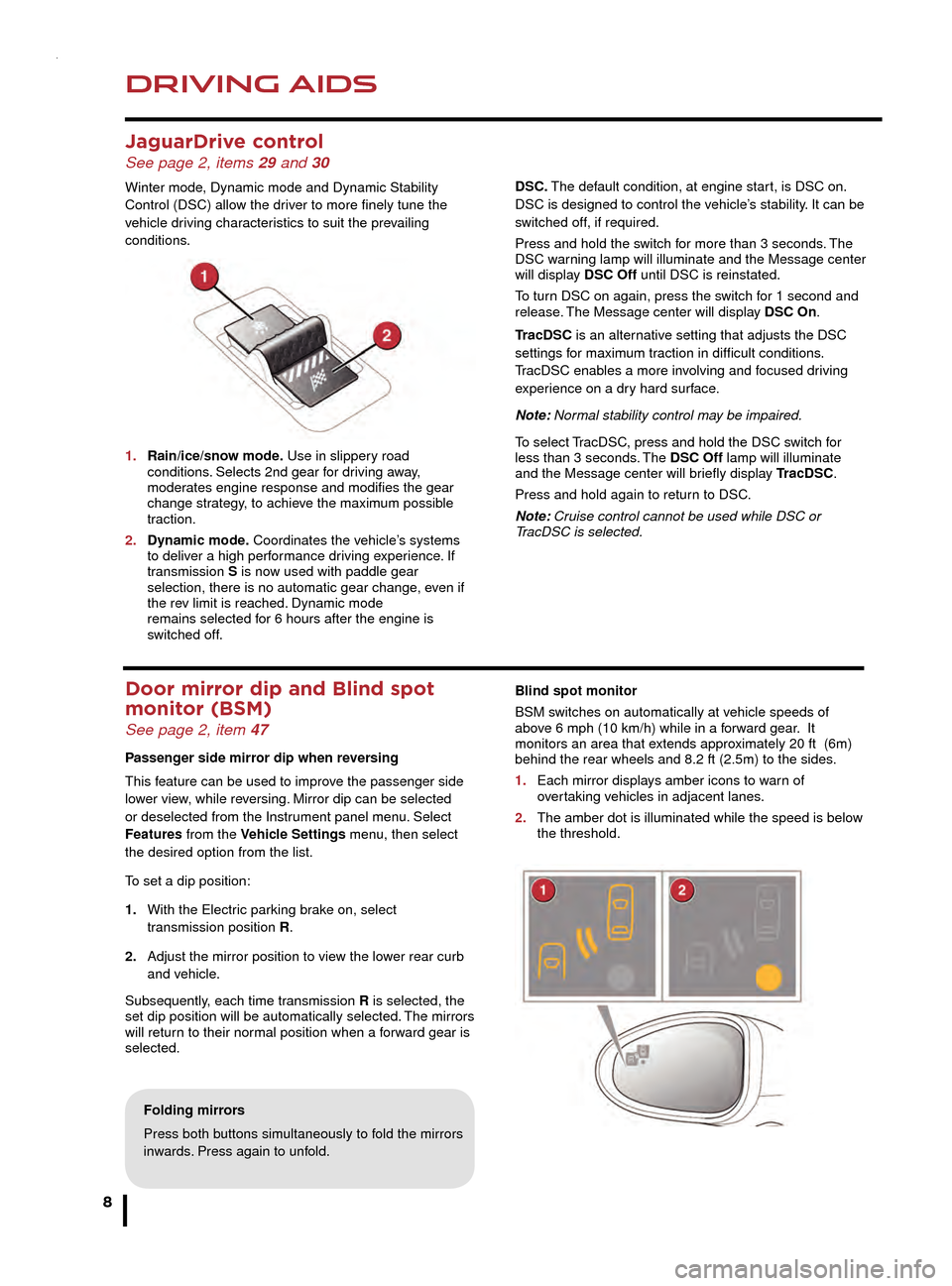
DRIVING AIDS
8
DRIVING AIDS
JaguarDrive control See page 2, items 29 and 30
Winter mode, Dynamic mode and Dynamic Stability
Control (DSC) allow the driver to more finely tune the
vehicle driving characteristics to suit the prevailing
conditions.
1.
Rain/ice/sno
w mode. Use in slippery road
conditions
. Selects 2nd gear for driving away,
moder
ates engine response and modifies the gear
change str
ategy, to achieve the maximum possible
traction.
2.
Dynamic mode
. Coordinates the vehicle’s systems
to deliv
er a high performance driving experience. If
transmission S is now used with paddle gear
selection, there is no automatic gear change
, even if
the re
v limit is reached. Dynamic mode
remains selected f
or 6 hours after the engine is
s
witched off.
Door mirror dip and Blind spot
monitor (BSM)
See page 2, item 47
Passenger side mirror dip when reversing
This feature can be used to improve the passenger side
lower view, while reversing. Mirror dip can be selected
or deselected from the Instrument panel menu. Select
Features from the Vehicle Settings menu, then select
the desired option from the list.
To set a dip position:
1.
With the Electr
ic parking brake on, select
tr
ansmission position R.
2.
Adjust the mirror position to vie
w the lower rear curb
and v
ehicle.
Subsequently, each time transmission R is selected, the
set dip position will be automatically selected. The mirrors
will return to their normal position when a forward gear is
selected.
Parking aids See page 2, item 14
When transmission R is selected, Parking aids at the rear
and front of the vehicle will activate.
1. The Touch screen will display a vehicle graphic and
indicate the approximate distance to any object
detected.
Note: Sensors may activate when water, snow, or ice are
detected on their surfaces. Make sure that the sensors
are cleaned regularly.
An audible alert will increase in frequency as the object is
approached.
When moving forwards into a space, activate the front
sensors with the Parking aid switch in the facia panel.
The audible alert volume can be adjusted via the Touch
screen. Select the Home menu, then Setup followed by
System. Now select Volume presets. Use the + or - soft
keys, alongside Parking aid, to adjust the volume.
Valet mode
The glove box, Luggage compartment, and the Touch
screen can be security locked to deny access to a
parking attendant. Before handing over your Smart key,
remove the emergency key blade and keep it in a safe
place.
Selecting Valet mode
1. From the Touch screen, select Home menu.
2. Now select Valet.
3. Enter a 4 digit PIN (personally chosen) and touch OK. You will be requested to confirm the PIN number.
4. Valet mode activated will be displayed.
Folding mirrors
Press both buttons simultaneously to fold the mirrors
inwards. Press again to unfold.
DSC. The default condition, at engine start, is DSC on.
DSC is designed to control the vehicle’s stability. It can be
switched off, if required.
Press and hold the switch for more than 3 seconds. The
DSC warning lamp will illuminate and the Message center
will display DSC Off until DSC is reinstated.
To turn DSC on again, press the switch for 1 second and
release. The Message center will display DSC On.
TracDSC is an alternative setting that adjusts the DSC
settings for maximum traction in difficult conditions.
TracDSC enables a more involving and focused driving
experience on a dry hard surface.
Note: Normal stability control may be impaired.
To select TracDSC, press and hold the DSC switch for
less than 3 seconds. The DSC Off lamp will illuminate
and the Message center will briefly display TracDSC.
Press and hold again to return to DSC.
Note: Cruise control cannot be used while DSC or
TracDSC is selected.
Blind spot monitor
BSM switches on automatically at vehicle speeds of
above 6 mph (10 km/h) while in a forward gear. It
monitors an area that extends approximately 20 ft (6m)
behind the rear wheels and 8.2 ft (2.5m) to the sides.
1.
Each mirror displa
ys amber icons to warn of
o
vertaking vehicles in adjacent lanes.
2.
The amber dot is illuminated while the speed is belo
w
the threshold.
Page 9 of 16
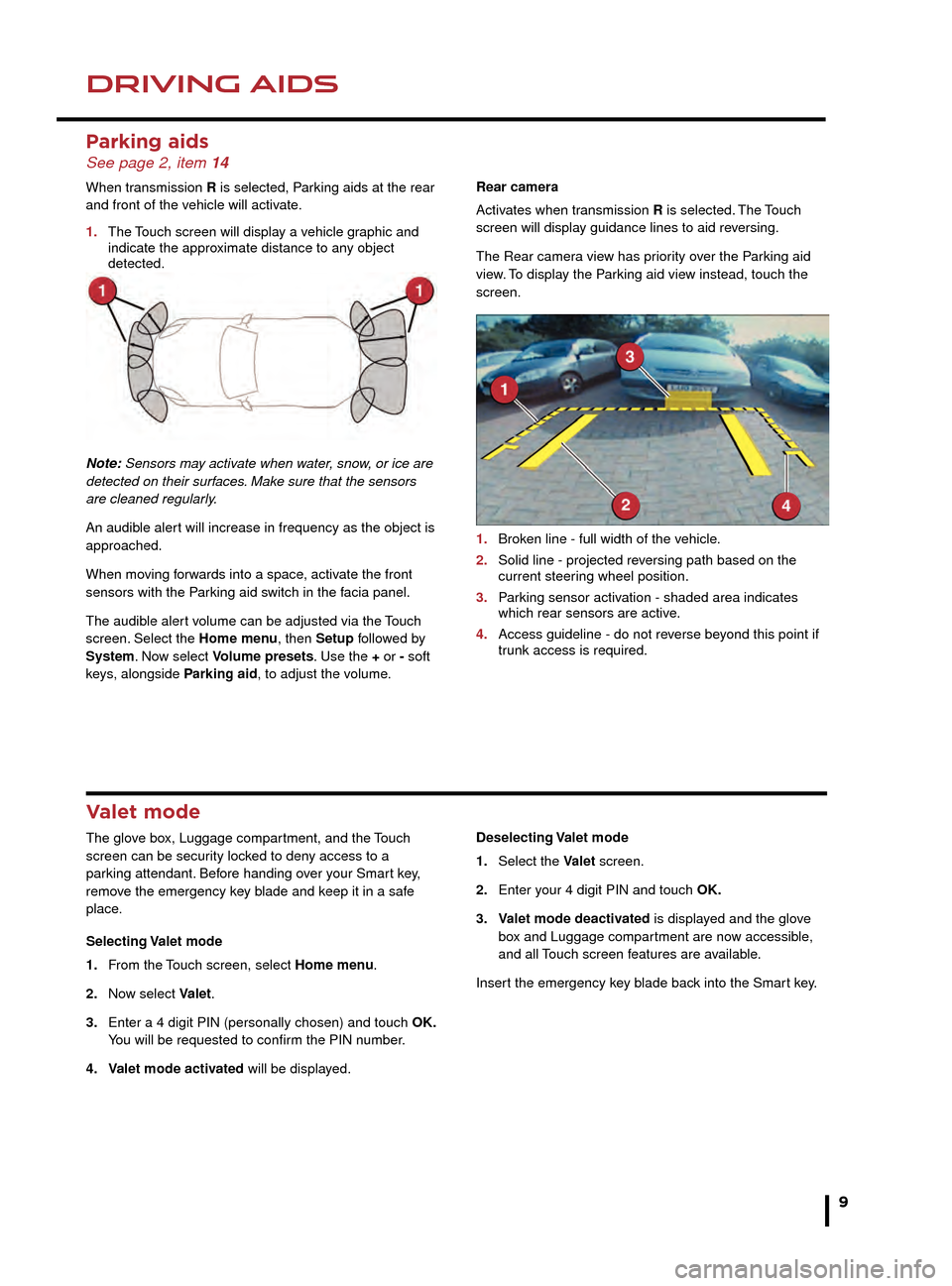
DRIVING AIDSDRIVING AIDS
9
Parking aids See page 2, item 14
When transmission R is selected, Parking aids at the rear
and front of the vehicle will activate.
1.
The
Touch screen will display a vehicle graphic and
indicate the appro
ximate distance to any object
detected.
Note: Sensors may activate when water, snow, or ice are
detected on their surfaces. Make sure that the sensors
are cleaned regularly.
An audible alert will increase in frequency as the object is
approached.
When moving forwards into a space, activate the front
sensors with the Parking aid switch in the facia panel.
The audible alert volume can be adjusted via the Touch
screen. Select the Home menu, then Setup followed by
System. Now select Volume presets. Use the + or - soft
keys, alongside Parking aid, to adjust the volume. Rear camera
Activates when transmission R is selected. The Touch
screen will display guidance lines to aid reversing.
The Rear camera view has priority over the Parking aid
view. To display the Parking aid view instead, touch the
screen.
1.
Brok
en line - full width of the vehicle.
2.
Solid line - projected re
versing path based on the
current steer
ing wheel position.
3.
P
arking sensor activation - shaded area indicates
which rear sensors are activ
e.
4.
Access guideline - do not re
verse beyond this point if
tr
unk access is required.
Valet mode
The glove box, Luggage compartment, and the Touch
screen can be security locked to deny access to a
parking attendant. Before handing over your Smart key,
remove the emergency key blade and keep it in a safe
place.
Selecting Valet mode
1.
F
rom the Touch screen, select Home menu.
2.
No
w select Valet.
3.
Enter a 4 digit PIN (personally chosen) and touch
OK.
Y
ou will be requested to confirm the PIN number.
4.
V
alet mode activated will be displayed. Deselecting Valet mode
1.
Select the
Valet screen.
2.
Enter y
our 4 digit PIN and touch OK.
3.
V
alet mode deactivated is displayed and the glove
bo
x and Luggage compartment are now accessible,
and all
Touch screen features are available.
Insert the emergency key blade back into the Smart key.
DSC. The default condition, at engine start, is DSC on.
DSC is designed to control the vehicle’s stability. It can be
switched off, if required.
Press and hold the switch for more than 3 seconds. The
DSC warning lamp will illuminate and the Message center
will display DSC Off until DSC is reinstated.
To turn DSC on again, press the switch for 1 second and
release. The Message center will display DSC On.
TracDSC is an alternative setting that adjusts the DSC
settings for maximum traction in difficult conditions.
TracDSC enables a more involving and focused driving
experience on a dry hard surface.
Note: Normal stability control may be impaired.
To select TracDSC, press and hold the DSC switch for
less than 3 seconds. The DSC Off lamp will illuminate
and the Message center will briefly display TracDSC.
Press and hold again to return to DSC.
Note: Cruise control cannot be used while DSC or
TracDSC is selected.
Blind spot monitor
BSM switches on automatically at vehicle speeds of
above 6 mph (10 km/h) while in a forward gear. It
monitors an area that extends approximately 20 ft (6m)
behind the rear wheels and 8.2 ft (2.5m) to the sides.
1. Each mirror displays amber icons to warn of
overtaking vehicles in adjacent lanes.
2. The amber dot is illuminated while the speed is below
the threshold.